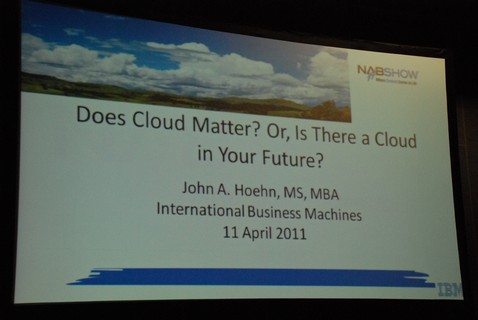NAB 2011 Thoughts
By bogaert|
NAB 2011 was somewhat different compared to the previous years, or maybe I departed with the wrong expectations. Herewith two observations: First, I was missing the 2011 next ‘big thing’. I spoke to a lot of people and asked for their highlights of this years show. Many of them could not express something they perceived as a highlight. Maybe is this caused by latest economic downturn, over the past years fewer investments might have been made in research and development of new products and services. Companies could present last year their innovations resulting from investments made before the economic downturn. This year looked somewhat different, although I must admit that many things they have been working on have been improved. Second, the entire show lacked customer centricity. Consumer electronics manufacturers demonstrated at the Consumer Electronics Show in January how an exceptional user experience might look alike, through end-to-end integration of device capabilities, network capabilities, and rich content. A new trend was definitely the multi-screen experience, synchronous viewing and interactions on different screens. For example, consumers can view linear programming on TV and access synchronous additional information and interaction possibilities along the linear program on a tablet. It seems that the content industry still neglects this trend, and does not organize itself to counter the lead taken by electronics manufacturers (and telecom operators). |
Playing Jeopardy with Watson at the IBM booth |
| Let me now give you my five reflections. |
| 1. Mobile | ||
| Content production and content delivery tools were around at many places, in particular for content distribution on tablets and smart-phones. | ||
| Like | The production of content in the format required for mobile devices gets finally automated and supports a wide variety of devices. | |
| Dislike | Content production for mobile devices is still seen as an auxiliary process, content is mainly reformatted without taking full advantage of the device capabilities. Few developments to exploit the new interaction possibilities enabled by advanced device capabilities and no developments to support the multi-screen trend. | |
| 2. Service Oriented Architectures (SOA) | ||
| The use of service oriented architectures in the content production workflow becomes (finally) accepted by multiple suppliers towards the industry. | ||
| Like | Finally a first step is set towards the standardization of SOA interfacing, using the Abstract Service Definition. The Framework for Interoperable Media (FIMS) offers limited standardized services and is supported by leading vendors in the industry (e.g., Avid, Sony, IBM) and by industry associations (e.g., EBU). | |
| Dislike | The evolution towards SOA is very slow, in particular slower then in other industries. Let’s hope the FIMS initiative speeds up the adoption of Service Oriented Architectures. | |
| 3. Cloud | ||
| The use of cloud is rather new in the traditional content industry. During the conference a special day with cloud session was on the program. These sessions were somewhat disappointing, either speakers explained cloud (general, not related to the content industry) or speakers explained web services and virtualization for content (without really touching cloud). A single exception was John A. Hoehn who touched the use of cloud in the content industry. At the show-floor a very limited number of booths mentioned cloud, but only a very few demoed a real cloud application. | ||
| Like | At least a start of using cloud in the content industry. Let’s be hopeful that a first step is set in the direction towards the adoption of cloud in the content industry. | |
| Dislike | I have the slight impression that most people in the industry still see cloud as a buzzword, and that they do not fully understand the value of cloud or the cloud business models that go along with the adoption of cloud. | |
| 4. Analytics | ||
| Customer centricity is coming! The first step towards the use of analytics in the traditional content industry is set. | ||
| Like | Finally content providers get interest in the individual consumer; customer centricity is seen as the next step forward. | |
| Dislike | US companies were interested in the use of analytics, probably because of the value they can capture when improving advertisings that goes along with the content. However, a weak interest from European companies, is Europe going to remain behind? | |
| 5. Stereoscopy (3D) | ||
| Stereoscopy was already shown over the past years at NAB. I expected it to be a big thing, but it was not. At the conference and at the show floor I saw many new 3D cameras, new ways to produce 3D content, and new ways to transmit 3D content. Many content producers and customers have recently invested in upgrading towards HD capable devices, thus additional investments for 3D might be delayed and cause a reason for slow adoption of stereoscopy. | ||
| Like | The image quality improved drastically, also the depth view is remarkable experience. | |
| Dislike | I am still annoyed by these uncomfortable 3D glasses. The discomfort of wearing stereoscopic glasses is probably a second reason why the adoption is moving forward slowly. | |
|
Cloud! John Hoehn speaker at NAB conference |
IBM booth at NAB (LVCC North hall) |
- bogaert's blog
- Log in to post comments



